Lead Conversion: Adaptation, Influence, and Customer Value
By Christopher P. Blocker, PhD, Laura Indergard, MBA, Jacqueline Simpson, MBA Candidate, Chris Matcek MBA/Masters of Engineering Candidate
Summary of Key Findings
A national study was conducted to explore the approaches that real estate agents use to influence their clients in face-to-face meetings. Findings revealed the following insights: 1. Agents use a variety of selling approaches. However, the study revealed two approaches that have widespread effectiveness for positively influencing clients: 1. Inspiring clients through appealing to their emotions and values and, 2. Providing clear recommendations that show potential benefits for clients. 2. Beyond these approaches, results demonstrate how important it can be for agents to adapt their selling efforts to an individual client's communication style. Specifically, results illustrate how approaches such as: (a) presenting information, (b) rapport building, (c) promising incentives, and (d) offering tactful warnings can prove to be effective, inconsequential, or detrimental depending on a client's communication style. 3. Being "customer-oriented" contributes significantly to client influence across all situations. This means demonstrating a high-concern for satisfying clients, creating value for them, and taking time to uncover their specific desires, both big and small. 4. Overall, findings suggest that salespeople who rely on standardized scripts and influence approaches should consider altering their presentations and selling styles to increase their levels of adaptation. Results indicate that doing so will enhance the influence agents have with clients, which in turn, helps them convert more listing appointments and attain higher personal performance (measured by gross commission income).
Acquiring New Clients Can Be More Art than Science
The first appointment with a potential client is critical. Clients are forming key impressions and, in a real estate context, are relying on their conversations and other clues to decide whether to "hire" the agent. Seasoned agents often expect to win new clients once they have gained this critical first appointment. Yet, in a crowded marketplace, rejection is common and sometimes the reasons for losing to a competitor remain a mystery.
Selling Formulas
In this uncertain environment, many salespeople consider their selling efforts a "numbers game" and memorize standardized scripts, approaches, and presentations to influence clients. This largely represents their personal "selling formula" - and just like science - it is held to be universally effective across most situations. This is no surprise; selling formulas can often build a track record of success and be quite useful. The downfall is that, unlike the science lab where the factors at play can be observed and are relatively stable over time, potential clients are richly complex individuals who are motivated by unseen goals and desires, which are shaped by their unique personalities, life histories, and dynamic circumstances. Beyond this, the overall landscape of the way salespeople and clients interact is constantly shifting as consumers in large mass have become more connected, sophisticated, and demanding over time. The net effect is that salespeople can encounter a colorful spectrum of individuals who may respond quite differently to uniform sales approaches and techniques. So, although selling formulas can be effective, the gap between having a good lead conversion rate and a best-in-class conversion rate may be the art of effectively adapting the selling approach to each individual and their perceptions of value. Since the livelihoods of salespeople sink or swim based on the success of their client interactions, it thus, behooves them to continually improve their ability to engage in the art of client adaptation.
The Art of Adaptation
Adaptive salespeople are constantly learning. Early in a sales call, they attempt to recognize a client's signals and reactions to better understand how the sales message can be customized for the unfolding sales interaction. At a more basic level, adaptive salespeople also assess client personalities, personal values, and styles of communicating. Exploring these areas can help uncover a client's psychological needs and how they prefer to socially interact with salespeople as they progress toward their decision. Understanding clients at this deeper level can help salespeople manage the overall client experience. From a sales perspective, the goal of these adaptations is having greater influence with clients and ultimately earning their business. The trick, however, is that adaptive selling can only prove useful for influencing clients if salespeople can determine just how they should adapt. Unfortunately, there is not much evidence from research conducted in a real estate context about the effectiveness of various approaches across different types of clients. Without robust insights in this area, real estate agents are left to trial-and-error and anecdotal evidence about how they should adapt. This gap in industry knowledge motivated the current study to explore questions like: What sales approaches are effective for influencing various types of real estate clients? Are there any sales approaches that appear universally effective in real estate selling? Are there any sales approaches that appear consistently detrimental in real estate selling?
Having Influence with Clients
In some ways the idea of "influencing" clients can appear to be a negative term associated with manipulation or unethical persuasion. In contrast, this study simply examines (within a real estate context) some basic influence strategies people use when communicating with each other that are applicable in a variety of contexts such as influence in interpersonal leadership. In other words, each of the influence strategies explored in this study can be utilized within the framework of an ethical selling philosophy that seeks to both satisfy customers as well as strive for superior sales performance.
Six Influence Strategies
To examine the research questions at hand, this study draws insight from recent research examining adaptive selling and six influence strategies that salespeople use frequently. These general influence strategies are described below: 1. Information exchange: informing clients with statistics, presenting materials, and using other information without making specific recommendations. 2. Recommendations: making clear suggestions or summary statements that advise clients to take a specific course of action that may prove beneficial for them. 3. Warnings: tactfully cautioning a client about potential negative outcomes, such as letting them know they may fail to get the best results in the selling process if they delay making a decision, go elsewhere, or discount the suggestions given. 4. Promises: offering the client a benefit of any type (special attention, discounting, small incentives, additional resources) to induce clients to go along with suggestions. 5. Inspirational appeals: appeals to the client's emotions, values, and/or ideals, by attempting to communicate (in content and style) with enthusiasm and conviction. 6. Rapport building: any non-selling personal talk to build rapport, such as discussing shared interests, complimenting the client, or just generally trying to make them feel good about themselves. Although these influence strategies are widely used with clients, recent studies show that these six influence strategies may impact different types of clients in a varied manner.
Client Orientations
As previously mentioned, individual clients bring their unique personalities into selling interactions; however, research helps classify clients using three buyer styles, which have also been called "orientations." These client orientations include: 1. Task-oriented: goal-oriented and purposeful clients that really want to accomplish the task at hand as efficiently as possible, and as such, can often place little value on any activity that deviates from the current task. 2. Socially-oriented: clients who believe that socializing is an important aspect of the interaction and are interested in fostering interpersonal relationships more so than getting immediately involved in the specific content of the task at hand. 3. Self-oriented: clients who tend to be preoccupied with themselves and their own welfare during their interactions and generally exhibit lower levels of task or social orientations.
Other Factors Measured in the Study
In addition to exploring influence approaches and buyer orientations, this study captured an agent's overall customer-orientation and situational factors like the population the agent works in, average home prices the agent sells, and years of experience as an agent. As agents reflected upon their use of various influence strategies, they also assessed their overall level of perceived influence with specific clients. Average conversion rates for client appointments and gross commission income (GCI) were then used to assess whether higher levels of influence impacted performance.
Results
Wide use of all six influence strategies. As shown below, results revealed that agents make moderate to extensive use of all six influence strategies. Specifically, use of information, recommendations, and inspirational appeals were used most extensively, averaging 5.6-5.7 on a scale ranging from very little use (1) to a great deal of use (7). 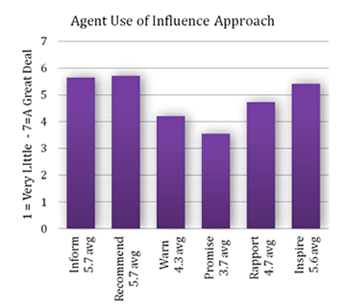 Influence strategy effectiveness. Beyond their widespread use, strategies demonstrated significantly different effects within those sales interactions. The charts below report results from the analysis of a series of statistical models. These models estimate the relationship between each influence strategy and the overall client influence across a sample of over 1,000 agents. Colored bars represent the positive (greater than zero) or negative (less than zero) effect for each strategy to facilitate influence with clients and lead conversion. Bars marked "not significant" represent scores for strategies that can be regarded as showing "no apparent effects" at all on overall client influence. So, for example, the combined sample for all clients shows that inspirational appeals (inspire), recommendations, and information exchange (inform) demonstrate a strong, positive impact on overall influence, and indicates that promises have a negative impact on influence. Warnings and rapport building demonstrated no significant impact.
Influence strategy effectiveness. Beyond their widespread use, strategies demonstrated significantly different effects within those sales interactions. The charts below report results from the analysis of a series of statistical models. These models estimate the relationship between each influence strategy and the overall client influence across a sample of over 1,000 agents. Colored bars represent the positive (greater than zero) or negative (less than zero) effect for each strategy to facilitate influence with clients and lead conversion. Bars marked "not significant" represent scores for strategies that can be regarded as showing "no apparent effects" at all on overall client influence. So, for example, the combined sample for all clients shows that inspirational appeals (inspire), recommendations, and information exchange (inform) demonstrate a strong, positive impact on overall influence, and indicates that promises have a negative impact on influence. Warnings and rapport building demonstrated no significant impact. 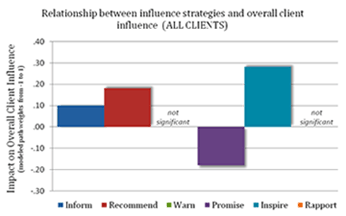 Influence strategy effectiveness by customer type. A key purpose of this study was to examine the need to adapt influence strategies. So, the six charts below illustrate the effects of different strategies when examining high and low levels of each client orientation type.
Influence strategy effectiveness by customer type. A key purpose of this study was to examine the need to adapt influence strategies. So, the six charts below illustrate the effects of different strategies when examining high and low levels of each client orientation type.
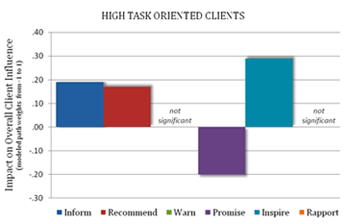 |
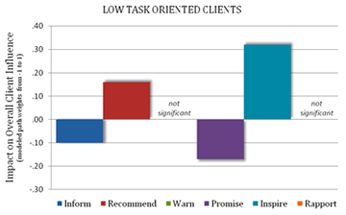 |
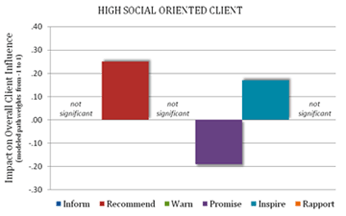 |
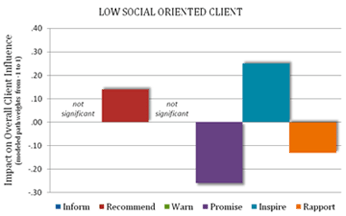 |
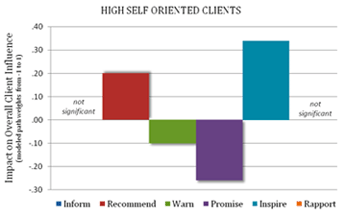 |
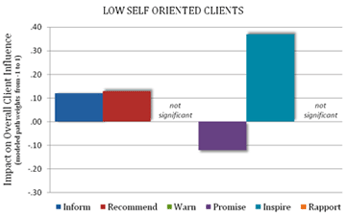 |
Inspirational appeals. These models reveal several tentative insights. First, inspirational appeals to emotions and ideals demonstrated the strongest effect in all cases, with exception of a highly social client, where it obtained the second highest effect. Agents making greater use of inspirational appeals also held higher lead conversation rates (79% versus 72%). These results coincide with other research which indicates that customers frequently experience emotions when they interact with salespeople. For example, during the process of selling their home, clients might encounter a range of emotions such as worry, frustration, excitement, and pleasure. Salespeople who have the ability to arouse positive emotions in customers may improve a client's overall experience, and, in turn, those clients may tend to be more satisfied and loyal to their agents. It is important to note here that, although inspirational appeals were a uniformly effective strategy, appealing to a specific client's emotions will look different based on customers' orientations and unique personalities. Human emotion stems from an individual's in-the-moment reactions to how they see their desires and goals being fulfilled or thwarted. In a real estate context, a socially-oriented client may be emotionally charged by a desire to work with an agent they believe cares about them as a person. Task-oriented clients, on the other hand, might experience emotions predominantly based upon whether they see opportunities to advance their personal task at hand. Recommendations. The only other influence strategy that obtained high effects in all cases was recommendations, and it showed the greatest impact with clients who have high social orientations. This influence strategy likely corresponds to a core characteristic that clients are looking for in real estate agents: trusted expertise. Information exchange. Interestingly, use of information, which appears to be a strong strategy in the overall sample, only showed a positive effect with high-task clients and clients with a low self-orientation. It actually had a negative impact with low task-oriented clients. A potential insight here is the possibility that agents can weaken their influence by relying too much on information exchange with prospects who may not desire a lot of it. Negative effect of promises. Use of promises, such as offering incentives of any type, demonstrated a consistent negative impact on overall influence in all situations. One possibility for this relatively surprising result is that agents by and large only offered incentives in cases where losing the client seemed likely without it. However, analyses showed that the promise approach was utilized with similar frequency across agents reporting wins versus losses. Further analysis confirmed a negative impact of promises on, not just influence, but also on overall lead conversion rates. That is, agents making greater use of promises in their interactions also held lower overall lead conversion rates (74% versus 77%) than agents who used promises less frequently. This difference was only a few percentage points; however, it was statistically significant across the large sample, meaning this result is unlikely to have occurred by chance. Insignificance of warnings and rapport building. With two exceptions that showed negative effects for warnings with high self-oriented clients and rapport building for low social-oriented clients, these approaches showed insignificant effects. Similar to other "non-significant" findings, these results do not necessarily mean that these strategies are of no use. Rather, they did not demonstrate enough of a difference amongst other strategies being captured in this study. We could also speculate that some minimal level of rapport is necessary in all selling situations or that rapport might even indirectly enhance other strategies like inspirational appeals and recommendations. Indeed, there is evidence that people tend to be influenced by those they like, which suggests that rapport supports other strategies. The main point here is that neither rapport building nor warnings demonstrated enough of an effect (outside the two exceptions mentioned above) to provide evidence that agents should emphasize or avoid these approaches in their interactions. Customer orientation and customer value. One significant result, which was tested in addition to the effects shown in the charts above, was the consistent, strong impact of an agent's "customer orientation" on their ability to positively influence clients. The average effect size was similar to the effects of recommendations across all the models. Higher levels of customer orientation also corresponded to higher lead conversion rates (76%) versus conversion rates for agents with lower levels of customer orientation (72%). Customer orientation captures an agent's ongoing emphasis on assessing what creates value for their clients and placing client satisfaction as a high priority. Influence strategies and performance. Other factors surely come into play when trying to convert leads into clients. However, the influence strategies measured in this study demonstrated statistically significant effects on agent influence with clients, lead conversion rates (.20 on a scale from 0 to 1), as well as personal performance (.14 on a scale from 0 to 1 and measured by GCI). So, the evidence in this study supports the idea that appropriate use of these influence strategies and customer orientation can enhance an agent's lead conversion rate and thus overall sales performance.
. . . . . . . . . . . . . . . . . . .
About the study and its caveats
The survey and analysis. This study surveyed 1,146 real estate agents and asked them to reflect upon a recent client interaction related to a potential listing. Questions demonstrated strong validity. Analyses were conducted using structural equation modeling. The models demonstrated close fit with the data and the effects obtained statistically significant parameters. This study is limited by the use of self-reported measures using agents to report on their perceived levels of influence with clients. Future studies should attempt to gather data from agents and clients as well as capture objective measures. Further information on the data and analysis is available upon request. Caveats to remember. The results contained in this study should be tentatively considered within the context of your own business, your personal selling experience, the types of clients you deal with, and local market conditions. As with any study, there are likely specific characteristics of your selling interactions that are not captured here, which may affect the value of applying these insights for a given agent. We hope you find the insights presented here to be helpful in continuously improving your selling skills and performance. If you have any questions or comments regarding this research, we would enjoy hearing them. Please feel free to use the feedback option at the top of the webpage where you found this article.
. . . . . . . . . . . . . . . . . . .
References:
Blocker, Christopher P. (2008) "Want to Convert More Leads into Clients? Dig Deeper into What Customers' Value," Keller Center Research Report, Baylor University. Johnston, Mark W. and Greg W. Marshall (2005), Relationship Selling and Sales Management. New York: McGraw-Hill Irwin. Hershey, L. (2005) "The Role of Sales Presentations in Developing Customer Relationships," Services Marketing Quarterly, 26 (3), 41-53. Day, George S. (2000), "Managing Market Relationships," Journal of the Academy of Marketing Science, 28 (1), 24-30. Parasuraman, A. (1997), "Reflections on Gaining Competitive Advantage through Customer Value," Journal of the Academy of Marketing Science, 25 (2), 154-61. Woodruff, Robert B. (1997), "Customer Value: The Next Source for Competitive Advantage," Journal of the Academy of Marketing Science, 25 (2), p. 139-54. Franke, G. R. and Park, J. (2006), "Salesperson Adaptive Selling Behavior and Customer Orientation: A Meta-Analysis," Journal of Marketing Research, 63 (November), 693-702. Gentile, Chiara, Spiller, Nicola, and Giuliano, Noci (2007), "How to Sustain the Customer Experience: An Overview of Experience Components that Co-create Value With the Customer," European Management Journal, 25 (5), 395-410. McFarland, Richard G., Challegalla, Goutam N., and Shervani, Tasadduq (2006), "Influence Tactics for Effective Adaptive Selling," Journal of Marketing, 70 (October), 103-117. Menon, K. and Dube, L. (2000) "Ensuring Greater Satisfaction by Engineering Salesperson Response to Customer Emotions," Journal of Retailing, 76: 285-307. Kidwell, B., McFarland, R.G., and Avila R.A. (2007) "Perceiving Emotion in the Buyer-Seller Interchange: The Moderated Impact on Performance," Journal of Personal Selling and Sales Management, 27 (2), 119-132. Reynolds, K.E. and Arnold, M.J. (2000) "Customer Loyalty to the Salesperson and the Store: Examining Relationship Customers in an Upscale Retail Context," Journal of Personal Selling and Sales Management, 20:89-98. Liu, Annie H., and Mark P. Leach (2001), "Developing Loyal Customers with a Value-adding Sales Force: Examining Customer Satisfaction and the Perceived Credibility of Consultative Salespeople," Journal of Personal Selling & Sales Management, 21 (2), p.147-156. Cialdini, R.B. (1988). Influence: Science and Practice. Glenville, IL: Scott, Foresman, and Company.
. . . . . . . . . . . . . . . . . . .
About the Authors:
Chris Blocker, PhD, Assistant Professor of Marketing, Baylor University
Chris completed his PhD at the University of Tennessee in marketing. His research focuses on understanding the dynamics of customer value and its implications for important strategies like relationship management and segmentation. Prior to pursuing a PhD in marketing, Chris held various marketing/sales positions in the high-tech sector, including work in professional services and as a global account manager for AT&T and in business marketing at Sprint. He has published research in respected journals such as Industrial Marketing Management, The European Journal of Marketing, The Journal of Business and Industrial Marketing, and in the proceedings of several international marketing organizations.
Laura Indergard, MBA, Baylor University
Associate Director Keller Center for Research and Keller Center for Professional Selling
Editor, Keller Center Research Report
Laura earned an MBA from Baylor University and a BS in Radio-TV-Film production from Texas Christian University. Her background includes work in the advertising industry as a copywriter for IT Network and as an independent small business consultant focusing on marketing and feasibility studies.
Jacqueline Simpson, MBA Candidate, May 2009, Baylor University
Graduate Assistant, Keller Center for Research
Jacqueline is a second year graduate student from Georgetown, TX. She earned her BBA with a double major in Marketing and International Business from Baylor University.
Chris Matcek, MBA/ME Candidate, Dec 2008, Baylor University
Graduate Assistant, Keller Center for Research
Chris is a second year graduate student from Katy, Texas. His undergraduate degree is in Electrical and Computer Engineering.